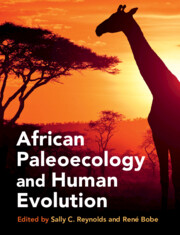Book contents
- African Paleoecology and Human Evolution
- African Paleoecology and Human Evolution
- Copyright page
- Dedication
- Contents
- Contributors
- Acknowledgments
- Part I Modern Africa and Overview of Late Cenozoic Paleoenvironments
- Part II Southern Africa
- Part III Eastern and Central Africa
- Part IV Northern Africa
- 36 The Northern African Sites: Paleoenvironmental Syntheses
- 37 Ahl al Oughlam, Morocco: The Richest Fossil Site in North Africa at the Pliocene/Pleistocene Boundary
- 38 Tighennif (Ternifine), Algeria: Environments of the Earliest Human Fossils of North Africa in the late Early Pleistocene
- 39 Early Homo on the Atlantic Shore: The Thomas I and Oulad Hamida 1 Quarries, Morocco
- Volume References
- Index
- Plate Section (PDF Only)
39 - Early Homo on the Atlantic Shore: The Thomas I and Oulad Hamida 1 Quarries, Morocco
from Part IV - Northern Africa
Published online by Cambridge University Press: 19 May 2022
- African Paleoecology and Human Evolution
- African Paleoecology and Human Evolution
- Copyright page
- Dedication
- Contents
- Contributors
- Acknowledgments
- Part I Modern Africa and Overview of Late Cenozoic Paleoenvironments
- Part II Southern Africa
- Part III Eastern and Central Africa
- Part IV Northern Africa
- 36 The Northern African Sites: Paleoenvironmental Syntheses
- 37 Ahl al Oughlam, Morocco: The Richest Fossil Site in North Africa at the Pliocene/Pleistocene Boundary
- 38 Tighennif (Ternifine), Algeria: Environments of the Earliest Human Fossils of North Africa in the late Early Pleistocene
- 39 Early Homo on the Atlantic Shore: The Thomas I and Oulad Hamida 1 Quarries, Morocco
- Volume References
- Index
- Plate Section (PDF Only)
Summary
The sites discussed here were first reported by Biberson (1961a) under the name of “carrières Thomas” derived from the name of the worker of these quarries. There were three of them, called Thomas I, II, and III from the NE to the SW, at 33.568° N, 7.698° W, in what are now the suburbs of Casablanca. Biberson did not use them much in his major synthesis (1961a) and proposed simplistic correlations based on mollusk faunas between Sidi Abderrahmane and Thomas Quarries successions, but this did not help to clarify the complex stratigraphy of the beginning of the Moroccan coastal Middle Pleistocene, where continental and marine deposits interdigitate; finally, Biberson reported some fossils of unknown whereabouts. In 1969, while the quarries were being worked for their calcarenite, a young student, Philippe Beriro, found a human mandible in a cave opened by quarry works at Thomas I. The mandible was first reported by Ennouchi (1969, 1970) and studied in more detail by Sausse (1975). Soon after, hominin remains were discovered in a cave in Thomas Quarry III (Ennouchi, 1972, 1975, 1976), but the site was rapidly destroyed by quarry works. All hominin fossils from Thomas quarries were at the time referred by Ennouchi (1970) to Atlanthropus mauritanicus. Later, Thomas Quarries I and II were merged into Thomas I, and the name of Thomas Quarry III changed first to “Ben Sina” and later to “Oulad Hamida 1,” which is the local toponym. Fossils associated with the human remains, as well as other fossils and Acheulean artifacts, were briefly studied by Geraads (1980a) and Geraads et al. (1980). At that time, one of us (J.-P.R.), together with Jean-Pierre Texier, was starting a revision of the Moroccan coastal Quaternary, for which the Thomas Quarries were key localities; he was joined by D.L. in 1989. Archeological excavations in several levels of Thomas Quarry I have been undertaken from 1988 onwards by J.-P.R. and colleagues, to be complemented in 1991 by the excavation in Oulad Hamida 1 Quarry of a large cave called “Grotte des Rhinocéros (GDR),” which is in geometric continuity with what Geraads (1980a) had called “fissures dans le Tensiftien de Thomas III.”
- Type
- Chapter
- Information
- African Paleoecology and Human Evolution , pp. 481 - 491Publisher: Cambridge University PressPrint publication year: 2022
- 1
- Cited by



